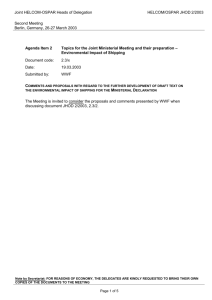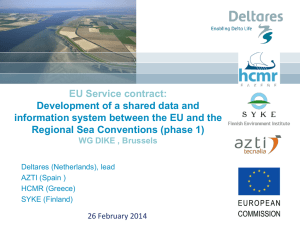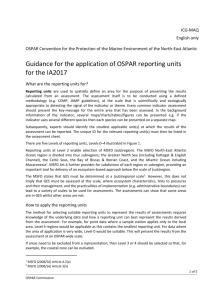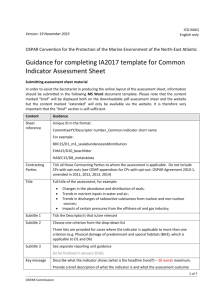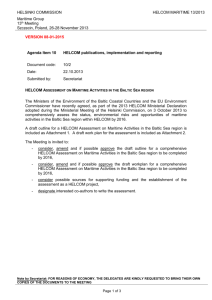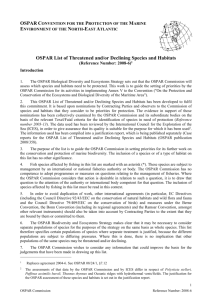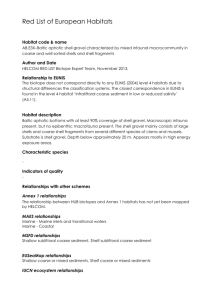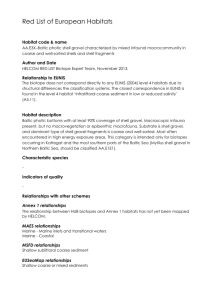Objectives Outcomes COBAM CORESET
advertisement
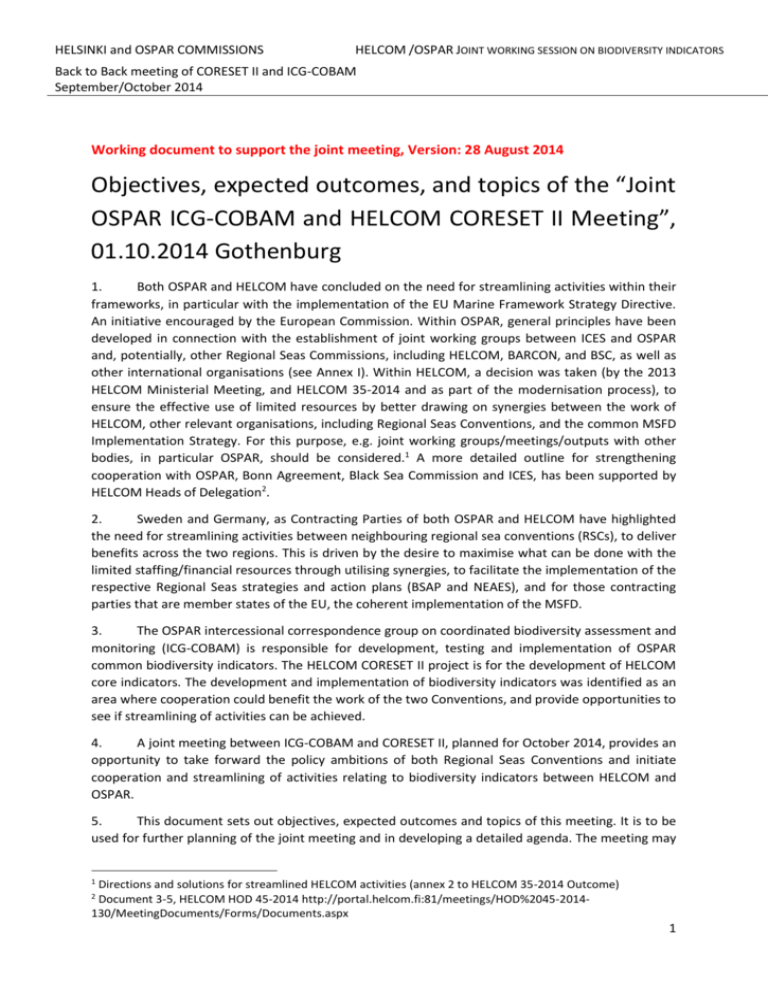
HELSINKI and OSPAR COMMISSIONS HELCOM /OSPAR JOINT WORKING SESSION ON BIODIVERSITY INDICATORS Back to Back meeting of CORESET II and ICG-COBAM September/October 2014 Working document to support the joint meeting, Version: 28 August 2014 Objectives, expected outcomes, and topics of the “Joint OSPAR ICG-COBAM and HELCOM CORESET II Meeting”, 01.10.2014 Gothenburg 1. Both OSPAR and HELCOM have concluded on the need for streamlining activities within their frameworks, in particular with the implementation of the EU Marine Framework Strategy Directive. An initiative encouraged by the European Commission. Within OSPAR, general principles have been developed in connection with the establishment of joint working groups between ICES and OSPAR and, potentially, other Regional Seas Commissions, including HELCOM, BARCON, and BSC, as well as other international organisations (see Annex I). Within HELCOM, a decision was taken (by the 2013 HELCOM Ministerial Meeting, and HELCOM 35-2014 and as part of the modernisation process), to ensure the effective use of limited resources by better drawing on synergies between the work of HELCOM, other relevant organisations, including Regional Seas Conventions, and the common MSFD Implementation Strategy. For this purpose, e.g. joint working groups/meetings/outputs with other bodies, in particular OSPAR, should be considered.1 A more detailed outline for strengthening cooperation with OSPAR, Bonn Agreement, Black Sea Commission and ICES, has been supported by HELCOM Heads of Delegation2. 2. Sweden and Germany, as Contracting Parties of both OSPAR and HELCOM have highlighted the need for streamlining activities between neighbouring regional sea conventions (RSCs), to deliver benefits across the two regions. This is driven by the desire to maximise what can be done with the limited staffing/financial resources through utilising synergies, to facilitate the implementation of the respective Regional Seas strategies and action plans (BSAP and NEAES), and for those contracting parties that are member states of the EU, the coherent implementation of the MSFD. 3. The OSPAR intercessional correspondence group on coordinated biodiversity assessment and monitoring (ICG-COBAM) is responsible for development, testing and implementation of OSPAR common biodiversity indicators. The HELCOM CORESET II project is for the development of HELCOM core indicators. The development and implementation of biodiversity indicators was identified as an area where cooperation could benefit the work of the two Conventions, and provide opportunities to see if streamlining of activities can be achieved. 4. A joint meeting between ICG-COBAM and CORESET II, planned for October 2014, provides an opportunity to take forward the policy ambitions of both Regional Seas Conventions and initiate cooperation and streamlining of activities relating to biodiversity indicators between HELCOM and OSPAR. 5. This document sets out objectives, expected outcomes and topics of this meeting. It is to be used for further planning of the joint meeting and in developing a detailed agenda. The meeting may 1 Directions and solutions for streamlined HELCOM activities (annex 2 to HELCOM 35-2014 Outcome) Document 3-5, HELCOM HOD 45-2014 http://portal.helcom.fi:81/meetings/HOD%2045-2014130/MeetingDocuments/Forms/Documents.aspx 2 1 HELSINKI and OSPAR COMMISSIONS HELCOM /OSPAR JOINT WORKING SESSION ON BIODIVERSITY INDICATORS Back to Back meeting of CORESET II and ICG-COBAM September/October 2014 propose steps for further joint activities between HELCOM and OSPAR on issues where synergy may have benefits for the whole of the respective Convention areas whilst ensuring the most efficient use of limited human and financial resources. The work could be taken forward through concrete actions by Contracting Parties to both conventions, as well as those that are only party to one convention by e.g. forming joint groups and using synergies in practice, where feasible. This meeting should be considered as a first step towards possible longer term ambitions for streamlining relevant biodiversity indicator activities between OSPAR and HELCOM. Objectives 3. The objectives for the joint meeting are: - Identify where OSPAR and HELCOM can learn from each other and where exchange of information will result in improved use of synergies; - To find synergies and streamline efforts where this is relevant, in work on biodiversity indicator development undertaken within individual Regional Seas Conventions. This is to increase coherence between Regional Seas Conventions and to make best possible use of the limited human and financial resources available for development of indicators and for the monitoring and assessment; - To inform development of programmes of measures under the EU MSFD; and - Improve awareness, communication and coordination between experts working on similar issues with the aim to establish networks and where it is found to be appropriate, joint working groups (using available structures and resources) for further knowledge and experience exchange and for cooperation on shared challenges. Expected outcomes 4. To achieve these objectives the meeting should aim to deliver specific outcomes. The sessions will be highly participative, with most of the work being undertaken in expert / technical break out groups. It is anticipated that the meeting will: - Identify specific areas of work and topics where cooperation is appropriate and feasible (in breakout groups with predefined broader remits to make best use of limited time; see below); - Identify and where possible propose suitable working arrangements to enable cooperation across RSCs while meeting short timeframes (e.g. joint expert groups across RSCs to merge individual groups already in existence within each RSC); and - Draft a joint communication paper, to be prepared immediately following the meeting, This paper would present the outcomes of the meeting and propose concrete follow-up actions and associated leads, including proposals on future joint activities between the RSCs on biodiversity indicators. This would be communicated with appropriate subsidiary bodies in the respective RSCs. 2 HELSINKI and OSPAR COMMISSIONS HELCOM /OSPAR JOINT WORKING SESSION ON BIODIVERSITY INDICATORS Back to Back meeting of CORESET II and ICG-COBAM September/October 2014 Discussion topics 5. It is proposed that the following topics are discussed during the meeting in Gothenburg in order to achieve the expected outcomes. The suggested topics are not intended to be exhaustive. 6. It is suggested that general topics are discussed in plenary sessions while more thematic/ ecosystem component specific topics are discussed in breakout groups. a. General topics: b. o Introduction to the differences and similarities in the approaches to indicator development; o Introduction of a proposed general concept on working arrangements; o Ensuring a common understanding on the tools available for defining spatial assessment units between the two conventions and implications of these choices for cooperation (e.g. which regional boundaries, sub regional boundaries, coastline are used in spatial analysis); and o Principle discussion on the opportunities for joint working arrangements for data and information management related to indicators (e.g. the identification and coordination of data calls, stewardship of data etc.). Topics for thematic breakout groups: The meeting will work in thematic break out groups to explore to what extent cooperation is useful in developing and implementing the HELCOM Core Indicators and OSPAR common indicators under the MSFD biodiversity themes/ ecosystem components and how this cooperation could work identify where cooperation may not be appropriate or useful. A generic framework will be made available as a meeting document to guide and structure the discussion of the break out groups, and facilitate contribution to the expected outputs. This generic framework will include questions such as: o Is it feasible/useful to cooperate in this theme or not? o If yes, to what degree is cooperation useful? o Is there a need for joint working on specific indicators? o If yes to explore and describe what is the nature of the joint work could be (development, research, testing)? What is the key joint output and benefit? What could the arrangements be? What might the remit of possible joint working goup(s) be? (including issues such as who provides the data, if conducting scientific reviews of the outputs / external QA are needed, etc.); o Are there Opportunities for coordination in longer-term indicator development, e.g. response to research calls. Experts actively working on indicator development and testing are invited to propose questions or issues that they feel need to be considered to streamline and achieve joint working for indicator development, testing and implementation between the OSPAR and HELCOM regions. Proposals should be sent to secretariat@ospar.org and Lena.Avellan@helcom.fi by 16 September 2014. Such 3 HELSINKI and OSPAR COMMISSIONS HELCOM /OSPAR JOINT WORKING SESSION ON BIODIVERSITY INDICATORS Back to Back meeting of CORESET II and ICG-COBAM September/October 2014 proposals would benefit from initial consideration on the type of cooperation, this may be through merging of groups, or perhaps “lighter” forms of cooperation – sharing expertise, data, research for example. Consideration of experience regarding existing monitoring requirements within each RSC would also be beneficial. Breakout group3 Vertebrate indicators Benthic habitats Food Webs / Pelagic Habitats NIS 3 Examples of issues to be discussed To discuss the integration of the requirements and the assessment approaches taken under the Habitats and Birds Directives within individual relevant Contracting Parties; To consider possibilities for cooperation between experts in the two RSCs …[proposals from experts]… To discuss integration and streamlining of the assessment of special habitats under the Habitats Directive across CPs; and To discuss development of a shared indicator on physical damage to the seafloor (e.g. OSPAR BH 3 – and Cumulative effects work being undertaken by HELCOM and OSPAR); and …[proposals from experts]… Discuss further development of OSPAR FW 4 Indicator (cf. MTI) to be used in both RSCs; and …[proposals from experts]… Benefit of establishing a European network of sampling stations for NIS trend indicators? …[proposals from experts]… Chairs for breakout groups to be confirmed. 4 HELSINKI and OSPAR COMMISSIONS HELCOM /OSPAR JOINT WORKING SESSION ON BIODIVERSITY INDICATORS Back to Back meeting of CORESET II and ICG-COBAM September/October 2014 Annex I: Extract from OSPAR document 14/8/6: General principles to be applied in connection with the establishment of joint working groups, between ICES and OSPAR, and potentially other Regional Seas Commissions, including HELCOM, BARCON, BSC as well as other international organizations Purpose Providing the science needed to implement the MSFD is a demanding task, particularly within the constraints of the MSFD time frame. There are a limited number of experts that are able to deliver this work and limited resources available. The proposal for establishing joint working groups would be to capitalise on potential synergies to deliver certain aspects of this work, avoid duplication, and maximize the use of limited resources and expertise. It is proposed the initial focus of these groups could be on issues such as Litter, Birds, Mammals, Fish, Food webs, depending on need. This would be kept under review by each organisation. Administration Costs: each organization/Contracting Party will cover any costs related to the arrangements of and participation in joint working groups, of any of their experts, members of Secretariat, etc. in line with each of their current rules. Labelling: the full name and acronym of the group will indicate the joint ownership, e.g.: “Joint ICES, HELCOM, OSPAR working group on [issue]”. To reflect this joint ownership, the acronym will begin JWG. Working arrangements Membership: each organization/Contracting Party will make use of its Rules of Procedure and established practice when deciding on participation. For practical and other reasons the organizations can jointly decide on a maximum number of participants, to be divided among them. The work of the Joint Working Groups will be science based and participants will be experts with competence within the area(s) considered. It will be important that the participating organizations have a joint/the same policy when it comes to allowing observers to the meetings, or at least an agreement in place prior to the meeting. Terms of Reference: the basis for the work of the joint working group shall be established in the Terms of Reference (ToR) adopted by the involved organizations, in accordance with their Rules of Procedure and practice. The ToR shall map the timetable for deliverables needed according to legal and policy instruments, and some supporting information (e.g. scientific justification etc.). In this process the nature of the different organizations shall be respected, and that the main aim of the joint working groups is to further the scientific understanding, in some instances by providing options, and consequences of various options. 5 HELSINKI and OSPAR COMMISSIONS HELCOM /OSPAR JOINT WORKING SESSION ON BIODIVERSITY INDICATORS Back to Back meeting of CORESET II and ICG-COBAM September/October 2014 Tenure: as a rule of thumb joint working groups will be established for a maximum of three years, after which their work and deliverables will be evaluated, with the view to decide whether to continue. Chairs: joint working groups will have a maximum of three chairs to be agreed by the participating organisations, with a preference for a single chair, possibly supported by one or two vice-chairs. Meeting documents: reports and other outcomes from the meeting will be considered public and made accessible online. Reports and other outcomes are published as expert reports and seen as such. Other deliverables could include peer-reviewed publications, cooperative research reports and standard manuals, guidelines etc. (such as the ICES CRR series and TIMES). Following a meeting, all meeting documents will be considered public and can be made available according to the organization’s practices (respecting confidentiality as appropriate). Nature of advisory products: The products of the joint working groups would not be subject to the formal ICES advisory process, unless this is specifically agreed by ICES. Any request for ICES advice would need to pass through the established request process. Number of meetings: the joint working group will normally have one physical meeting a year, and can otherwise work inter-sessionally via e-mail or virtual meetings. Timing of meetings: The timing of the meeting should be responsive to, but not limited by the timetable set by the CIS of the MSFD. It may be that the timing needs to fit with the meeting cycle of more than one of the organisations and may differ from the existing routines. Meeting location: Meetings may take place at the respective organizations headquarters, or in a participating country, based on the preference of the Joint Group, and availability of meeting rooms. 6
